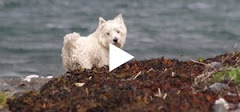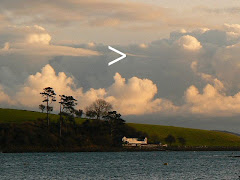 In the last hour of the last day of 2009, Lynn and I observed a little ritual on the island foreshore. I was going to say 'tradition', but that would only really be true of the people from whom we borrowed it. Even then, we didn't borrow it directly but from someone whose life was inextricably linked with those same people, and whose story has intrigued and inspired me since I first came across it fifteen years ago.
In the last hour of the last day of 2009, Lynn and I observed a little ritual on the island foreshore. I was going to say 'tradition', but that would only really be true of the people from whom we borrowed it. Even then, we didn't borrow it directly but from someone whose life was inextricably linked with those same people, and whose story has intrigued and inspired me since I first came across it fifteen years ago.In 1922 a shy, reflective young woman named Edith Warner left the family home in Pennsylvania and travelled southwest, to the high desert country of Northern New Mexico, and a little timber-frame cottage on a hillside overlooking the Rio Grande, and the 250ft long, single-lane suspension bridge that carried Highway 502 – the Los Alamos Highway – across its muddy reach.
The bridge was known as Otowi, a name borrowed from the pueblo Indians to whom the area had been home for centuries. Three miles northeast along the Rio Grande was San Ildefonso pueblo, famous then and now for its silk-smooth, black-on-black pottery; and ten miles west, in the remote foothills of the Jemez Mountains, was The Ranch at Los Alamos – a boys' prep school, founded in 1900 by one Ashley Pond and having a reputation, not surprisingly, for healthy outdoor activities.
Edith had found her spiritual home, and quickly earned the respect and affection of her Native American neighbours by assuming nothing, and listening well.
Otowi was the literal gateway to the mountains, and to make ends meet Edith took to serving tea and cake from the front parlour of her cottage to travellers in, or out. Her first customers were wanderers, surveyors, a few teachers. Then in 1943, shortly after entering the war and in utmost secrecy, the US government acquired The Ranch for its first and most world-changing atomic research programme, codenamed The Manhattan Project and charged with heading off Hitler's Germany in the race to design and build a workable atomic bomb.
Suddenly, Edith's customers included names like Oppenheimer, Teller and Bohr, and the tea room was filled with the hum and banter of a steady stream of military and scientific personnel who stopped by to enjoy her famous chocolate cake, and who talked about everything – it must have seemed so strange – everything except 'the project'.
To help with chores Edith took on a pueblo elder, a tall, black-haired man from San Ildefonso, and for the rest of her life Tilano was her spiritual guide, her sounding-board and her true companion. It was Tilano who introduced Edith to the pueblo custom of lighting a fire in the dying moments of the Old Year, to welcome in the spirits of the New – a custom which Lynn and I borrowed twelve years ago and have observed ever since, most recently on the Islandmore foreshore at midnight on 31st December 2009.
 Twenty-two years after Edith Warner's death, her friend Peggy Pond Church (whose father Ashley had founded the Los Alamos school at the turn of the century) published her biography, under the title The House at Otowi Bridge. It is a classic of New Mexico literature and conveys with great sensitivity the qualities of this remarkable woman, and in particular her ability to bring humility and humanity to bear in reconciling the seemingly irreconcilable extremes, in terms of ways and aspirations, of two very different kinds of neighbour.
Twenty-two years after Edith Warner's death, her friend Peggy Pond Church (whose father Ashley had founded the Los Alamos school at the turn of the century) published her biography, under the title The House at Otowi Bridge. It is a classic of New Mexico literature and conveys with great sensitivity the qualities of this remarkable woman, and in particular her ability to bring humility and humanity to bear in reconciling the seemingly irreconcilable extremes, in terms of ways and aspirations, of two very different kinds of neighbour.Edith Warner died of cancer in 1951, with Tilano by her side.














